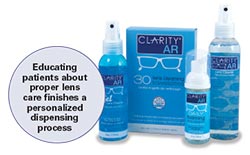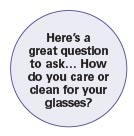|
Your monthly guide to staff training outside the box
Eyes / Lenses / Fitting Lenses / Free-Form / Frames / Sunwear / Patient Solutions / In-office / Standards
LENSES: Cleaning,
Aftercare and Anti-Fog
Sponsored by nanofilm
CLEANING AR AND SUPERHYDROPHOBIC COATINGS
These specialty coatings are “slick” and actually repel moisture, which can make cleaning them difficult and spotty. Consider carrying a specialty cleaner, like Nanofilm’s Clarity AR, which is formulated to spread to counteract the slick surface. It spread completely, lifts off soils and carries them away with the wipe of a cleaning cloth.
|
DANG, THESE LENSES ARE SMEARY AND SCRATCH EASILY

Consumers typically reach for the bad stuff to clean their lenses. Dish soap, Windex, hand soap and dirty kitchen towels are, in a word, awful choices for sophisticated lenses and coatings. Try asking this question: “Would you go out and wipe your car’s finish with a dry kitchen towel?” Yet they get frustrated about scratches, smudges and refer to their damaged lens coatings as anyone’s responsibility but their own. This leads to remakes and overuse of scratch warranties. And all this is going on in a value-focused economy.
A good lens care plan will not only help your clients to ensure the best possible vision; it also enables you to derive a new and profitable revenue stream from the sales of a family of lens care products. Don’t be timid or uncomfortable with the idea of actively selling cleaners, cloths and wipes. You’ll be surprised at how much more frequently clients will enter your office. Rather than just at exam time or when they’ve sat on their eyewear, they’ll be in to say “hi” while purchasing refill cleaner kits, wipes and a new cloth.
See Plus »
|
|


|
EFFECTIVE ANTI-FOG FOR SPORTS, WORK AND EVERYDAY

You may be surprised at how many people have a problem with fogged eyewear—nearly 50 percent according to some studies. For some, it’s a sports problem, for others, it’s a daily hazard in the workplace. And for others, it’s simply the everyday annoyance of steamy kitchens, temperature changes from indoors to outdoors, or close up craft work.
How does fog form? When water molecules strike a surface that is much colder than the ambient air—such as the eyeglass lenses of someone who just walked into the room from the cold—they slow down and stick together faster than air currents can blow them apart. You’ve got “magnetic attraction” creating watery fog.
See Plus »
|
LENS CARE TOWELETTES
Towelettes are small, which makes packing them a breeze. So you’re never left without one, pack a few in each bag, camera case, eyeglass case or purse before you go. More importantly, towelettes are convenient. Cloth and solution are all in one. Simply open, wipe, go. Towelettes will provide you that crystal clear view as you’re bound to come across a few annoying fingerprinted lenses throughout any three-hour tour.
See Plus »
|
KIDS’ EYEGLASSES—CARE AND CLEANING

The results of a PPG survey (500 adults, March 2012) showed that parents do feel that eyecare professionals could play a greater role in two major ways. First, ECPs should educate parents and their children on lens options that provide better solutions for the way that children use their glasses. Second, there is an essential need for children to better understand how to care for their eyewear. After all, eyeglasses can be a substantial investment, and habits for how well they’re cared for start young.
See Plus »
|
A SPARKLING FINISH
Place a variety of lens care products right at the front of your reception counter and at your dispensing tables. Be sure all of them are labeled with your store information, as well as a price (this establishes value). Introduce products for the variety of cleaning and care situations a client will encounter with their eyewear. For example: Sports, sweat and general steaminess = anti-fog; on the go with little carrying space = pre-moistened towelettes; Best in value = larger size bottles for home use.
Not just a giveaway? A giveaway over time can lessen the value or importance of the product. Keep the quantity that is given away limited. Provide sample towelettes, as they introduce the patient to convenient lens care and will develop into a great repeat business. Be sure to demonstrate their proper use. It should not be thrown into the bag, as in “here’s some cleaner for you.” This also provides an opportunity to inform customers to return for additional products as spray and towelettes are expendable, and microfiber cloths will get dirty.
See Plus »
|
COMMON CARE ISSUES MENTIONED

More than half of the parents surveyed said that their kids dropped, mishandled or improperly cleaned their eyeglasses or didn’t use a case. Not keeping glasses on or getting them scratched or dirty gets in the way of good visual information. If kids can’t see well through their glasses, they think glasses aren’t working.
In addition to being taught the proper way to care for eyeglasses, parents should also understand the options available for making lenses more durable, like scratch-resistant lenses and AR coatings. Combined, they prevent scratches and dirt buildup.
See Plus »
|
TIPS FOR MORE EFFECTIVE CARE
Add a short lens care discussion as part of the exam process, then re-do it at the end of the dispensing process. Ask patients to echo back instructions, adding in humor for kids. In your office, highlight the importance of the doctor speaking directly to kids, especially when they are getting their first pair of glasses. Develop a script that doctors, techs and opticians know for consistency in communications.
|
LENS CARE PRESERVES EYEWEAR AND CUSTOMER SMILES
Nanofilm understands the way customers feel about their new glasses—and the disappointment that damage can cause.
Dish soaps, household cleaners, hand soaps or window cleaners? The powerful ingredients in these cleaners are designed to remove soap scum and food particles and can contain very aggressive chemicals, which can actually harm the anti-reflective (AR) coating on the lens. Hand soap in your bathroom can contain moisturizers, which means you’re going to have greasy residue all over your glasses. Window cleaners can contain ammonia, which can damage AR coatings. So “soap and water” is a very broad term… the stuff in soap and water can actually damage your glasses.
Nanofilm’s Clarity AR lens cleaning solution is specifically formulated to work with the hydrophobic treatments to spread over the lens and grip lens contaminants, lifting them off the lens surface so that they can be cleanly wiped away with a microfiber cloth. The result is a lens cleaning process that gives the wearer crystal clear vision with the security of a cleaner that will not damage the lenses.
|
|


|
|